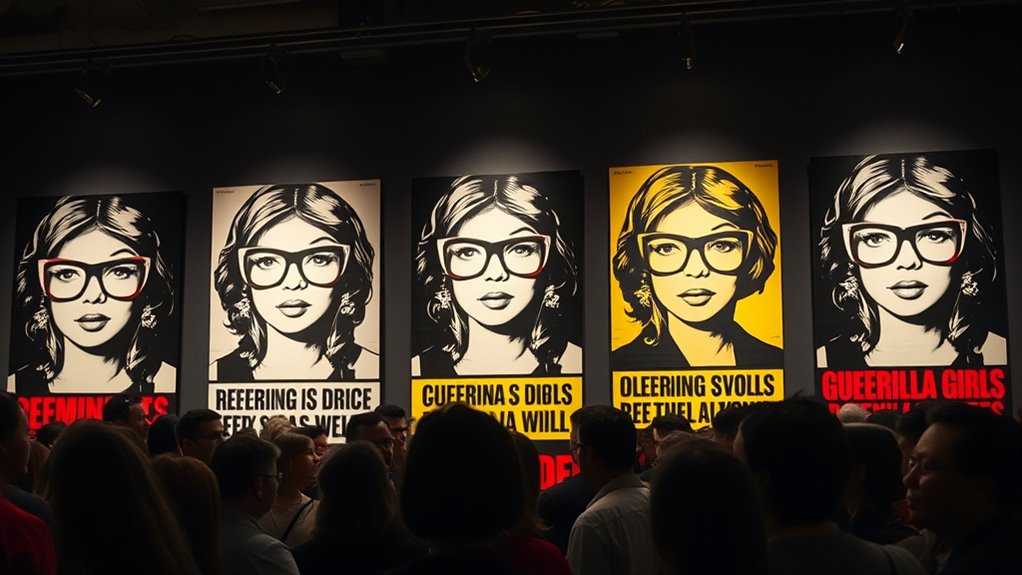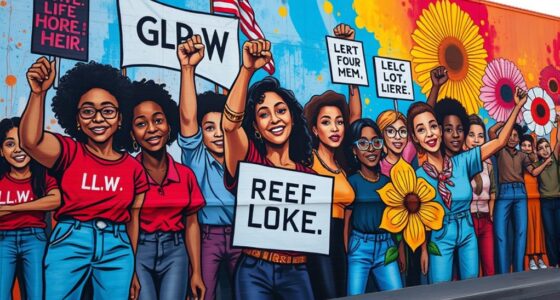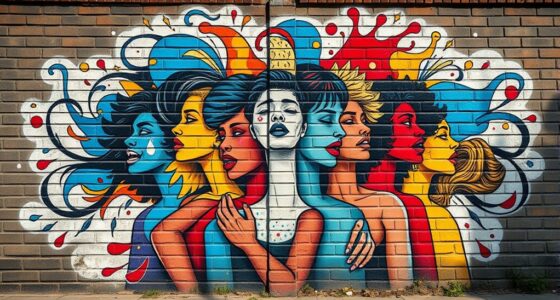The Guerrilla Girls revolutionized feminist art activism by using bold visuals, satire, and covert tactics to expose sexism and inequality in the art world. They challenge societal norms through provocative posters, public projects, and digital campaigns, encouraging dialogue on issues like representation and inclusivity. Despite facing censorship and controversy, their influence persists today, inspiring new strategies that incorporate intersectionality and innovative art forms. To discover how their efforts continue shaping activism, explore more about their impactful work.
Key Takeaways
- The Guerrilla Girls, founded in 1985, use provocative visual tactics and anonymity to challenge gender inequality in the art world.
- They employ striking posters, public art, and satire to expose sexism, promote inclusivity, and reshape feminist discourse.
- Their activism faces challenges like censorship, tokenism, and institutional resistance, but continues to evolve through digital platforms.
- The group integrates innovative approaches such as environmental art and new media to amplify their messages and engage wider audiences.
- Intersectionality and digital activism ensure their feminism remains relevant, impactful, and focused on promoting diversity and social change.
The Origins and Formation of the Guerrilla Girls
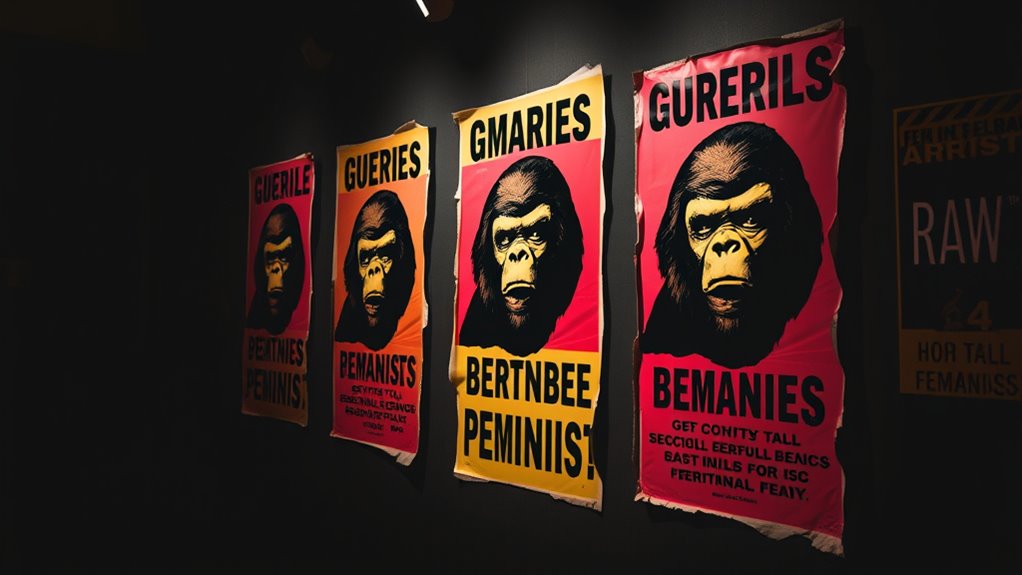
Have you ever wondered how a group of anonymous feminist artists made a powerful impact on the art world? The answer lies in their origins rooted in the historical context of gender inequality in art. During the 1980s, women artists faced significant exclusion from galleries and exhibitions, sparking frustration and activism. The Guerrilla Girls formed in 1985 as a response, blending feminist origins with a bold, confrontational approach. They chose anonymity to emphasize ideas over individual fame and to critique the male-dominated art scene. Their formation was a reaction to systemic bias, aiming to challenge and expose sexism in art institutions. This strategic starting point set the stage for their distinctive activism, blending feminist principles with guerrilla tactics to reshape perceptions and demand equality. Embracing artistic expression despite societal barriers has been central to their mission.
Signature Tactics and Artistic Approach

The Guerrilla Girls employ striking visual tactics that combine provocative posters, stickers, and billboards to draw immediate attention to gender inequalities in the art world. They utilize bold visual symbolism, like gorilla masks and contrasting black-and-white images, to create instantly recognizable symbols of their movement. Their artistic approach often relies on satirical humor, using wit and irony to challenge mainstream narratives and expose disparities. By blending sharp satire with powerful imagery, they provoke thought and stir debate while maintaining anonymity to focus attention on the message rather than individual identities. This combination of visual symbolism and satirical humor makes their activism compelling and memorable, ensuring their messages resonate widely and persistently in public consciousness. Additionally, their engagement in remote hackathons demonstrates how digital platforms can expand access and foster creativity within activism efforts.
Notable Campaigns and Public Projects
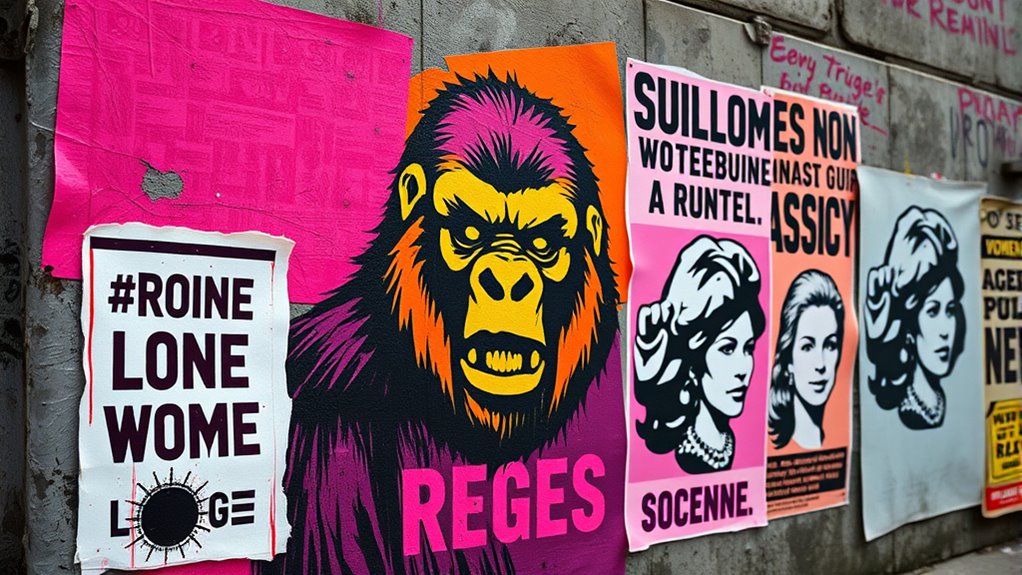
You’ll see how feminist artists have launched powerful campaigns that challenge societal norms. Public art installations serve as bold statements, engaging communities and sparking conversations. These campaigns and projects highlight the impact of art in advocating for gender equality. Effective communication strategies are essential for amplifying their messages and reaching wider audiences.
Notable Campaigns Overview
What are some of the most impactful feminist art campaigns that have sparked public conversations and shifted perceptions? The Guerrilla Girls excel at using visual symbolism and clever campaign strategies to challenge sexism in the art world. Their campaigns often feature striking posters, stickers, and public projects that expose discrimination with bold graphics and provocative messages. These campaigns effectively engage audiences and create dialogue around gender inequality. Their efforts also include affiliate disclosure to support their activism initiatives, ensuring transparency about their partnerships. Below is a quick overview of notable campaigns:
Public Art Installations
Public art installations have become powerful tools for feminist activists to amplify their messages and engage communities directly. Through striking visual displays and strategic placement, these projects influence public perception, challenging societal norms and highlighting gender inequality. Artistic symbolism plays a key role, transforming public spaces into platforms for dialogue and awareness. For example, guerrilla-style murals and provocative sculptures draw attention to issues like reproductive rights or workplace discrimination. By doing so, activists foster conversations that might not occur in traditional settings. These installations often evoke emotional responses, making the message memorable and impactful. As a result, they help shift perceptions, inspire collective action, and demonstrate the potency of art as a form of activism in the public sphere. Incorporating elements of Aboriginal art, such as the use of dots and storytelling, can add cultural depth and resonance to these campaigns.
Impact on the Art World and Feminist Discourse
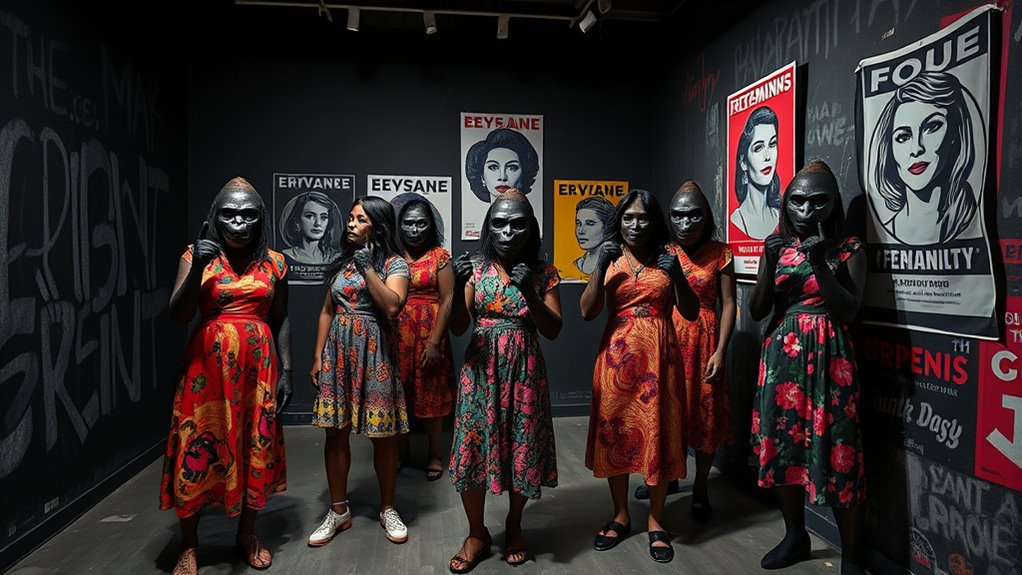
Your engagement with feminist art activism shows how artists challenge traditional norms and push boundaries. These efforts amplify feminist voices and reshape conversations within the art world. As a result, feminist discourse becomes more influential and integrated into mainstream artistic practices. Incorporating diverse styles of art further broadens the impact of feminist activism.
Challenging Artistic Norms
Challenging artistic norms has especially reshaped both the art world and feminist discourse by questioning traditional representations and values. You see, the Guerrilla Girls led an artistic rebellion that pushes boundaries, spotlighting issues like gender representation. Their provocative posters and performances challenge the status quo, exposing disparities and stereotypes embedded in mainstream art. This act of defiance encourages others to rethink what counts as art and who gets to be seen. By breaking conventions, they prompt conversations about inclusivity and equality, making it clear that norms aren’t sacred. Your engagement with this movement highlights how disrupting established standards can open space for marginalized voices and shift perceptions, fostering a more honest and diverse artistic landscape. Feminist art activism continues to inspire new generations to challenge systemic inequalities through creative expressions.
Amplifying Feminist Voices
How have feminist artists used their work to amplify marginalized voices and reshape conversations in the art world? They focus on intersectional representation, highlighting diverse identities and experiences often overlooked. Through bold visuals and provocative messages, they challenge dominant narratives and demand visibility for underrepresented groups. These artists employ social justice strategies, turning activism into powerful art that sparks dialogue and awareness. Their work pushes institutions to reconsider inclusion, equity, and representation, making feminist discourse central to contemporary art. By amplifying voices that have long been silenced, they transform the art scene into a platform for societal change. This approach not only elevates individual stories but also fosters a broader understanding of intersectionality, ensuring feminism’s impact resonates across diverse communities and conversations. Additionally, they utilize AI content clusters to strategically organize and amplify their messages, increasing the reach and impact of their activism.
Challenges and Controversies Faced by the Collective

Feminist art activism often faces significant obstacles that threaten its progress and visibility. Tokenism can dilute the movement’s message, reducing genuine representation to superficial gestures. Censorship also poses a major challenge, as controversial works are sometimes suppressed or ignored, limiting dialogue. The Guerrilla Girls encounter skepticism from institutions that prefer to maintain the status quo, dismissing their provocative messages. They also contend with preppy dog names, which can sometimes trivialize serious issues when used in inappropriate contexts. These challenges force the collective to navigate a landscape that often resists change, risking marginalization while pushing for visibility and justice in feminist art.
Continuing Influence and Modern Activism
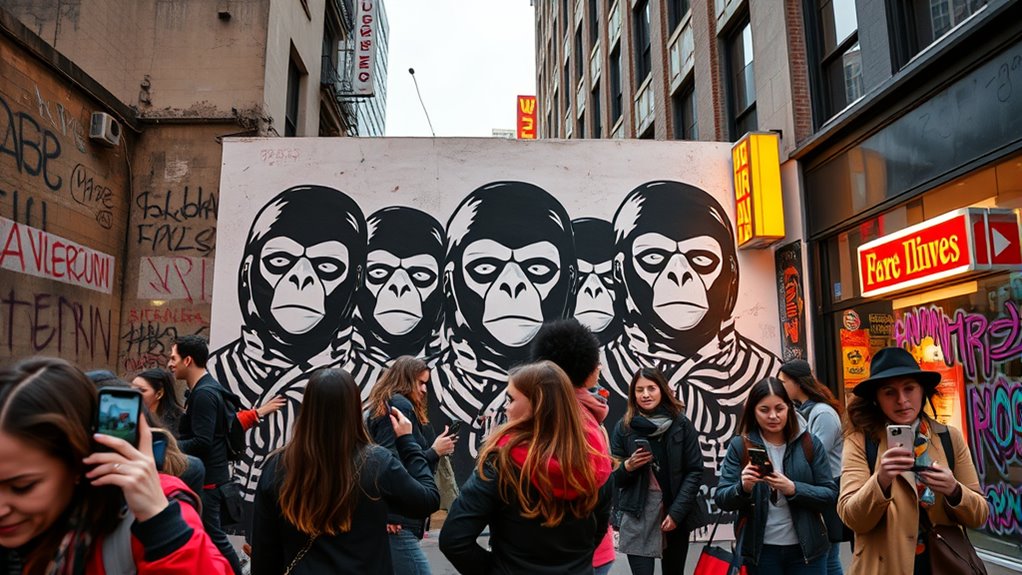
Despite the obstacles feminist art activism has faced, its influence continues to resonate and evolve in the modern era. You see, today’s activists leverage increased intersectionality awareness to address overlapping social issues, making their campaigns more inclusive and nuanced. Digital activism plays a vital role, allowing you to share powerful messages globally, mobilize support instantly, and challenge traditional art spaces. Guerrilla Girls and other groups now use social media, online exhibitions, and viral campaigns to keep feminist art activism alive and relevant. This digital shift empowers you to participate actively, amplify marginalized voices, and hold institutions accountable. Additionally, the rise of innovative art forms like self-watering and waterless planters demonstrates how creative approaches can symbolize sustainability and resilience, inspiring new tactics in activism. The blend of intersectionality awareness and digital tools ensures that feminist art activism remains dynamic, adaptable, and impactful in shaping ongoing conversations about equality and representation.
Frequently Asked Questions
How Do Guerrilla Girls Select Their Specific Campaigns?
You select your specific campaigns by using sharp artistic strategies that highlight social issues and challenge the status quo. You focus on campaign targeting by identifying areas where gender inequality, discrimination, or underrepresentation are most evident in the art world and beyond. Your approach involves choosing provocative visuals and messages that grab attention, provoke thought, and inspire action, ensuring each campaign effectively raises awareness and pushes for change.
What Is the Significance of Their Iconic Gorilla Mask?
Imagine stepping into the 21st century and realizing the iconic gorilla mask’s significance. It’s your artistic symbolism, hiding identities to emphasize collective activism over individual fame. This mask’s cultural impact lies in challenging societal norms and demanding visibility for women in art and beyond. It’s a powerful visual statement, reminding you that activism can be anonymous, yet loud — making their message resonate far beyond the art world.
How Do They Maintain Anonymity While Gaining Visibility?
You maintain anonymity through visual anonymity and identity preservation by consistently wearing masks, like the iconic gorilla masks, during public appearances and performances. This approach shifts focus from individual identities to the message, allowing you to challenge sexism and inequality without personal exposure. By hiding your faces, you guarantee your activism isn’t linked to personal fame, making your message more powerful and relatable, while safeguarding your privacy.
What Funding Sources Support Their Activism Efforts?
You should know that their activism is supported by funding organizations and donor support, which provide essential financial backing. These sources enable the Guerrilla Girls to create impactful posters, protests, and campaigns. By securing funds from diverse organizations and individual donors, they maintain independence and focus on their feminist messages. Their strategic fundraising efforts ensure they can continue challenging gender inequality in the art world and beyond.
How Do They Measure Success in Their Campaigns?
You measure the success of their campaigns through artistic impact and increased public awareness. When their provocative posters and performances spark conversations and challenge stereotypes, you see their activism thriving. If more people recognize the issues they highlight and demand change, it indicates they’ve achieved meaningful influence. Their ability to engage diverse audiences and provoke reflection shows that their activism is effective and impactful.
Conclusion
As you reflect on the Guerrilla Girls’ fierce activism, their bold voice continues to cut through the art world’s silence like a lightning bolt illuminating hidden truths. Their work sparks change, challenging injustice and inspiring new generations of creators to stand up and speak out. Just as a torchbearer lights the way in darkness, their legacy ignites hope and action, proving that even in silence, art can be a powerful force for revolution.
